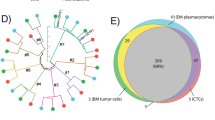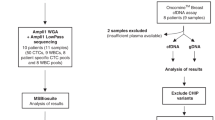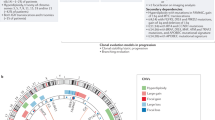Abstract
Mutational characterisation in multiple myeloma (MM) currently relies on bone marrow (BM) biopsy, which fails to capture the putative spatial and genetic heterogeneity of this multifocal disease. Analysis of plasma (PL)-derived circulating free tumour DNA (ctDNA) as an adjunct to BM biopsy, for mutational characterisation and tracking disease progression, was evaluated. Paired BM MM cell DNA and ctDNA from 33 relapsed/refractory (RR) and 15 newly diagnosed (ND) patients were analysed for KRAS, NRAS, BRAF and TP53 mutations using the OnTarget Mutation Detection (OMD) platform. OMD detected 128 mutations (PL=31, BM=59, both=38) indicating the presence of PL mutations (54%). A higher frequency of PL-only mutations was detected in RR patients than ND (27.2% vs 6.6%, respectively), authenticating the existence of spatial and genetic heterogeneity in advanced disease. Activating RAS mutations were more highly prevalent than previously described with 69% harboring at least one RAS mutation. Sequential ctDNA quantitation with droplet digital PCR through longitudinal PL tracking of specific clones in seven patients demonstrated changes in fractional abundance of certain clones reflective of the disease status. We conclude that ctDNA analysis as an adjunct to BM biopsy represents a noninvasive and holistic strategy for improved mutational characterisation and therapeutic monitoring of MM.
This is a preview of subscription content, access via your institution
Access options
Subscribe to this journal
Receive 12 print issues and online access
$259.00 per year
only $21.58 per issue
Buy this article
- Purchase on Springer Link
- Instant access to full article PDF
Prices may be subject to local taxes which are calculated during checkout






Similar content being viewed by others
References
Kuehl WM, Bergsagel PL . Early genetic events provide the basis for a clinical classification of multiple myeloma. Hematology Am Soc Hematol Educ Program 2005; 1: 346–352.
Lohr JG, Stojanov P, Carter SL, Cruz-Gordillo P, Lawrence MS, Auclair D et al. Widespread genetic heterogeneity in multiple myeloma: implications for targeted therapy. Cancer Cell 2014; 25: 91–101.
Walker BA, Boyle EM, Wardell CP, Murison A, Begum DB, Dahir NM et al. Mutational spectrum, copy number changes, and outcome: results of a sequencing study of patients with newly diagnosed myeloma. J Clin Oncol 2015; 33: 3911–3920.
Egan JB, Shi CX, Tembe W, Christoforides A, Kurdoglu A, Sinari S et al. Whole-genome sequencing of multiple myeloma from diagnosis to plasma cell leukemia reveals genomic initiating events, evolution, and clonal tides. Blood 2012; 120: 1060–1066.
Egan JB, Kortuem KM, Kurdoglu A, Izatt T, Aldrich J, Reiman R et al. Extramedullary myeloma whole genome sequencing reveals novel mutations in Cereblon, proteasome subunit G2 and the glucocorticoid receptor in multi drug resistant disease. Br J Haematol 2013; 161: 748–751.
Melchor L, Jones JR, Lenive O, Peterson EA, Brioli A, Murison A et al. Spatiotemporal analysis of intraclonal heterogeneity in multiple myeloma: unravelling the impact of treatment and the propagating capacity of subclones using whole exome sequencing. Blood 2015; 126: 371.
de Haart SJ, Willems SM, Mutis T, Koudijs MJ, van Blokland MT, Lokhorst HM et al. Comparison of intramedullary myeloma and corresponding extramedullary soft tissue plasmacytomas using genetic mutational panel analyses. Blood Cancer J 2016; 6: e426.
Forshew T, Murtaza M, Parkinson C, Gale D, Tsui DW, Kaper F et al. Noninvasive identification and monitoring of cancer mutations by targeted deep sequencing of plasma DNA. Sci Transl Med 2012; 4: 136ra168.
Murtaza M, Dawson SJ, Tsui DW, Gale D, Forshew T, Piskorz AM et al. Non-invasive analysis of acquired resistance to cancer therapy by sequencing of plasma DNA. Nature 2013; 497: 108–112.
Demetri GD, Jeffers M, Reichardt P, Kang YK, Blay JY, Rutkowski P et al. Mutational analysis of plasma DNA from patients (pts) in the phase III GRID study of regorafenib (REC) versus placebo (PL) in tyrosine kinase inhibitor (TKI)-refractory GIST: correlating genotype with clinical outcomes. J Clin Oncol 2013; 31:abstract10503.
Kaedbey R, Kis O, Danesh A, Dowar M, Li TT, Li ZH et al. Noninvasive diagnosis of actionable mutations by deep sequencing of circulating tumor DNA in multiple myeloma. Clin Lymphoma Myeloma Leuk 2015; 15: e45–e46.
Rustad EH, Dai HY, Coward E, Misund K, Sundan A, Waage A . Detection and monitoring of BRAF and NRAS mutant clones in myeloma patients by digital PCR of circulating DNA. Blood 2015; 126: 4196.
Spencer A, Mithraprabhu S, Ramachandran M, Klarica D, Hocking J, Mai L et al. Evaluation of circulating tumour DNA for the mutational characterisation of multiple myeloma. Blood 2015; 126: 368.
Mithraprabhu S, Kalff A, Chow A, Khong T, Spencer A . Dysregulated class I histone deacetylases are indicators of poor prognosis in multiple myeloma. Epigenetics 2014; 9: 1511–1520.
Das K, Norton SE, Alt JR, Krzyzanowski GD, Williams TL, Fernando MR . Stabilization of cellular RNA in blood during storage at room temperature: a comparison of cell-free RNA BCT((R)) with K3EDTA tubes. Mol Diagn Ther 2014; 18: 647–653.
Qin J, Williams TL, Fernando MR . A novel blood collection device stabilizes cell-free RNA in blood during sample shipping and storage. BMC Res Notes 2013; 6: 380.
Kidess E, Heirich K, Wiggin M, Vysotskaia V, Visser BC, Marziali A et al. Mutation profiling of tumor DNA from plasma and tumor tissue of colorectal cancer patients with a novel, high-sensitivity multiplexed mutation detection platform. Oncotarget 2015; 6: 2549–2561.
Beaver JA, Jelovac D, Balukrishna S, Cochran RL, Croessmann S, Zabransky DJ et al. Detection of cancer DNA in plasma of patients with early-stage breast cancer. Clin Cancer Res 2014; 20: 2643–2650.
Chesi M, Brents LA, Ely SA, Bais C, Robbiani DF, Mesri EA et al. Activated fibroblast growth factor receptor 3 is an oncogene that contributes to tumor progression in multiple myeloma. Blood 2001; 97: 729–736.
Kuehl WM, Bergsagel PL . Multiple myeloma: evolving genetic events and host interactions. Nat Rev Cancer 2002; 2: 175–187.
Liu P, Leong T, Quam L, Billadeau D, Kay NE, Greipp P et al. Activating mutations of N- and K-ras in multiple myeloma show different clinical associations: analysis of the Eastern Cooperative Oncology Group Phase III Trial. Blood 1996; 88: 2699–2706.
Rizvi NA, Hellmann MD, Snyder A, Kvistborg P, Makarov V, Havel JJ et al. Cancer immunology. Mutational landscape determines sensitivity to PD-1 blockade in non-small cell lung cancer. Science 2015; 348: 124–128.
Acknowledgements
We thank the staff from Clinical Haematology, Alfred Health for organising sample collection. This work was supported by a grant from the Black Swan Research Initiative, International Myeloma Foundation.
Author contributions
SM, BD and AS were responsible for design of the study. SM, TK, MR, AC, LM, SW, DB, AM and MW designed and performed experiments and analysed data. MR, DK, JH and AK were responsible for recruiting patients, procuring and processing samples for the study. SM and AS wrote the manuscript. All authors contributed to editing and final approving of the manuscript.
Author information
Authors and Affiliations
Corresponding author
Ethics declarations
Competing interests
LM, SW, DB, AM and MW are employees and shareholders of Boreal Genomics (Vancouver, BC, Canada). All other authors declare no conflict of interest.
Additional information
Supplementary Information accompanies this paper on the Leukemia website
Supplementary information
Rights and permissions
About this article
Cite this article
Mithraprabhu, S., Khong, T., Ramachandran, M. et al. Circulating tumour DNA analysis demonstrates spatial mutational heterogeneity that coincides with disease relapse in myeloma. Leukemia 31, 1695–1705 (2017). https://doi.org/10.1038/leu.2016.366
Received:
Revised:
Accepted:
Published:
Issue Date:
DOI: https://doi.org/10.1038/leu.2016.366
This article is cited by
-
Liquid biopsy by analysis of circulating myeloma cells and cell-free nucleic acids: a novel noninvasive approach of disease evaluation in multiple myeloma
Biomarker Research (2023)
-
Monitoring multiple myeloma in the peripheral blood based on cell-free DNA and circulating plasma cells
Annals of Hematology (2022)
-
Multiples Myelom aus Sicht der Pathologie
Der Radiologe (2022)
-
Cell-free DNA for the detection of emerging treatment failure in relapsed/ refractory multiple myeloma
Leukemia (2022)
-
Liquid biopsy: an evolving paradigm for the biological characterisation of plasma cell disorders
Leukemia (2021)



